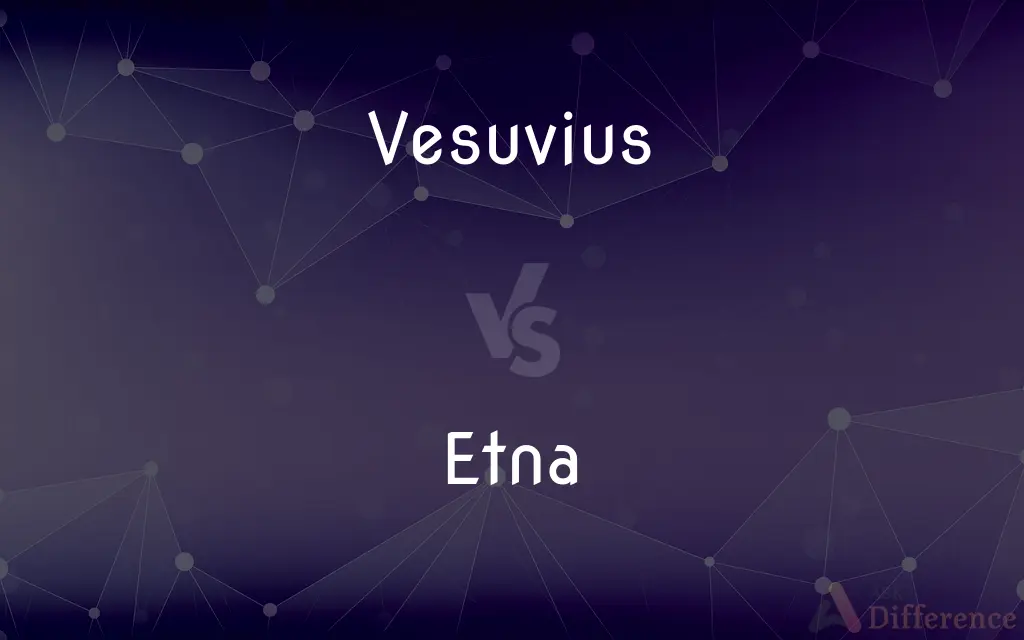Vesuvius vs. Etna — What's the Difference?
By Tayyaba Rehman & Urooj Arif — Updated on April 8, 2024
Vesuvius, infamous for the AD 79 Pompeii eruption, looms over Naples, Italy, while Etna, Europe's tallest active volcano, dominates eastern Sicily with more frequent eruptions.

Difference Between Vesuvius and Etna
Table of Contents
ADVERTISEMENT
Key Differences
Vesuvius is notably recognized for its catastrophic eruption in AD 79 that buried Pompeii and Herculaneum, showcasing its explosive volcanic activity. Whereas, Etna, standing as the highest volcano in Europe, is known for its more frequent but less devastating eruptions, providing fertile soil for agriculture in its vicinity.
While Vesuvius has a history of large, explosive eruptions that have significantly impacted human settlements, Etna's eruptions are often characterized by lava flows and ash plumes that can disrupt air travel but are generally less deadly. On the other hand, Etna's consistent activity contributes to its role as a key subject of scientific research and monitoring, offering insights into volcanic behavior and hazards.
Vesuvius remains a major subject of study due to its destructive history and the potential threat it poses to the densely populated region of Campania. Etna, however, is celebrated for its natural beauty and is a UNESCO World Heritage Site, attracting tourists and researchers alike to its slopes.
Vesuvius's eruptions, although less frequent in modern times, pose a significant risk due to the urban areas surrounding it, necessitating advanced monitoring and evacuation plans. In contrast, Etna's regular eruptions have allowed for the development of strategies to mitigate their impact, benefiting from the volcano's predictable patterns.
Despite the differences in their eruptive styles and the nature of their threats, both Vesuvius and Etna play significant roles in their respective regions' cultures, economies, and histories, underscoring the complex relationship between humans and nature.
ADVERTISEMENT
Comparison Chart
Location
Near Naples, Italy
Eastern Sicily, Italy
Type of Volcano
Composite
Shield Volcano
Eruption History
Famous for the AD 79 eruption; less frequent
Europe’s most active; frequent eruptions
Impact
Catastrophic, with potential for high casualties
Less deadly but disruptive to air travel
Significance
A threat to the densely populated Campania region
UNESCO World Heritage Site; agricultural benefits
Compare with Definitions
Vesuvius
Advanced technology is used to monitor its activity.
Vesuvius's monitoring systems help provide early warnings.
Etna
Europe's tallest active volcano, located in Sicily, Italy.
Etna's frequent eruptions contribute to fertile soils.
Vesuvius
Its eruption preserved ancient Roman cities in ash.
Pompeii offers insights into Roman life before Vesuvius erupted.
Etna
Its fertile slopes support agriculture.
Vineyards and orchards thrive on Etna's slopes.
Vesuvius
Poses a significant risk to Naples due to potential eruptions.
Vesuvius is closely monitored by volcanologists.
Etna
Known for regular lava flows and ash plumes.
Etna's activity is a focus of ongoing volcanic research.
Vesuvius
A composite volcano in Italy, known for its catastrophic AD 79 eruption.
Vesuvius's eruption history is studied to understand volcanic hazards.
Etna
A key subject for studying volcanic behavior.
Etna's eruptions provide data for volcanic hazard assessments.
Vesuvius
Despite the danger, it attracts many visitors.
Tourists climb Vesuvius to view the crater and Pompeii.
Etna
A UNESCO World Heritage Site attracting many tourists.
Hiking trails on Etna offer stunning views.
Vesuvius
A volcano in southwestern Italy on the Mediterranean coast; a Plinian eruption in 79 AD buried Pompeii and killed Pliny the Elder; last erupted in 1944
Etna
A kind of small, portable cooking apparatus for which heat is furnished by a spirit lamp.
Etna
A kind of small, portable, cooking apparatus for which heat is furnished by a spirit lamp.
There should certainly be an etna for getting a hot cup of coffee in a hurry.
Etna
An inactive volcano in Sicily; last erupted in 1961; the highest volcano in Europe (10,500 feet)
Etna
A gas burner used in laboratories; has an air valve to regulate the mixture of gas and air
Common Curiosities
What type of volcano is Vesuvius?
Vesuvius is a composite volcano, characterized by explosive eruptions.
What is the significance of Etna's fertile slopes?
They support diverse agriculture, benefiting the local economy.
Why is Etna considered Europe's most active volcano?
Due to its consistent eruptive activity and frequent lava flows.
What makes Vesuvius's AD 79 eruption notable?
Its eruption buried Pompeii and Herculaneum, preserving them in ash.
Why is Etna a UNESCO World Heritage Site?
For its natural beauty, geological significance, and biodiversity.
What is the risk level of living near Vesuvius today?
High, due to the potential for devastating eruptions and the dense population.
What attracts tourists to Etna?
Its natural landscapes, hiking trails, and geological interest.
How often does Vesuvius erupt?
Its eruptions are infrequent but potentially very destructive.
How do scientists study Etna's eruptions?
Through continuous monitoring and research on its lava flows and ash plumes.
How does the volcanic activity of Vesuvius and Etna differ?
Vesuvius is known for catastrophic eruptions, while Etna's activity is more frequent but generally less violent.
How do the locations of Vesuvius and Etna impact their respective regions?
Both are near populated areas, but their eruptions have different impacts due to their nature and frequency.
What are the benefits of Etna's regular eruptions?
They contribute to the fertility of the soil, aiding agriculture.
What cultural impact did Vesuvius's AD 79 eruption have?
It preserved Roman cities, offering a glimpse into ancient life.
Can Vesuvius's eruptions be predicted?
While difficult, monitoring efforts aim to provide early warnings.
What makes Vesuvius a significant threat?
Its potential for large eruptions near densely populated areas.
Share Your Discovery

Previous Comparison
Confirm vs. Reaffirm
Next Comparison
Jailer vs. TurnkeyAuthor Spotlight
Written by
Tayyaba RehmanTayyaba Rehman is a distinguished writer, currently serving as a primary contributor to askdifference.com. As a researcher in semantics and etymology, Tayyaba's passion for the complexity of languages and their distinctions has found a perfect home on the platform. Tayyaba delves into the intricacies of language, distinguishing between commonly confused words and phrases, thereby providing clarity for readers worldwide.
Co-written by
Urooj ArifUrooj is a skilled content writer at Ask Difference, known for her exceptional ability to simplify complex topics into engaging and informative content. With a passion for research and a flair for clear, concise writing, she consistently delivers articles that resonate with our diverse audience.















































